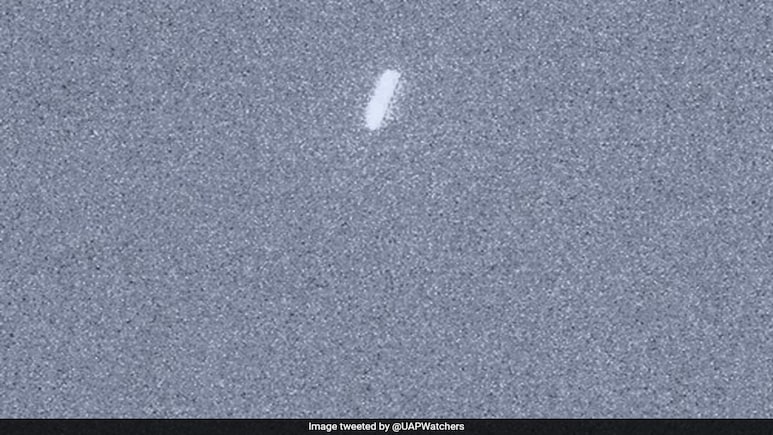
- Image of comet 3I/ATLAS by Mars Perseverance rover shows bright, cylindrical object in sky
- Comet 3I/ATLAS flew by Mars on October 3, measuring around 46 kilometres in diameter
- Experts say image shape likely caused by long exposure, not actual cylindrical form
An alleged photo of interstellar comet 3I/ATLAS, captured by NASA's Mars Perseverance rover, has gone viral on social media. The image shows a bright, cylindrical object zooming through the Martian sky, fueling speculation about its true nature. Some are questioning whether it's a comet or an "alien mothership," as suggested by Harvard astrophysicist Avi Loeb. However, experts suggest the unusual shape is likely an artifact of the long integration time used to capture the image, rather than an actual cylindrical shape.
The comet, which flew by Mars on October 3, is estimated to be around 46 kilometers in diameter and is moving at an incredible 60 km/sec.
Amid this, several people claimed to have found the first image of the mysterious object by analysing NASA's raw images. Enthusiasts like Stefan Burns and Simeon Schmauß have been poring over the data, with some sharing their findings online. Burns created a time-lapse using 9 minutes of images captured by Mars Perseverance on October 2, observing an object moving rapidly across the night sky.
Is this 3I/ATLAS?! I created a time-lapse using 9 minutes of images captured by Mars Perseverance on October 2nd, and we clearly observe something traveling very fast across the night sky against the normal motion of travel (due to Mar's rotation). Remember that #3IATLAS is… pic.twitter.com/cbxv006jCx
— Stefan Burns (@StefanBurnsGeo) October 3, 2025
Schmauß also spotted a faint smudge of light near the comet's predicted location, sparking intense speculation. His analysis suggests NASA's Perseverance rover might have captured an early glimpse of interstellar comet 3I/ATLAS on October 1st as it zoomed past Mars.
"After stacking 20 images from Mastcam-Z, I found a faint smudge of light in the constellation Corona Borealis close to the location where the comet was expected," he wrote.
If confirmed, the Perseverance images could offer the earliest glimpse of 3I/ATLAS from Mars' surface.
Here are other posts going viral:
🚨NASA Released Mars Perseverance Image Of 3I/ATLAS
— Skywatch Signal (@UAPWatchers) October 5, 2025
NASA's Mars Perseverance rover acquired this image using its onboard Right Navigation Camera (Navcam). The camera is located high on the rover's mast and aids in driving.
This image was acquired on Oct. 4, 2025 (Sol 1643) at… pic.twitter.com/ZSNK9o5T5W
🚨 NEW IMAGE FROM MARS: 3I/ATLAS spotted again — and this time, it doesn't look like a comet. #3IATLAS
— Scott C'one (@The_White_Fist) October 5, 2025
A perfect glowing cylinder drifting across the Martian sky.
No dust plume. No fragmentation. Just… structure.
What are we really looking at here?#3IATLAS pic.twitter.com/4G5GY5A5kJ
🚨 These are the alleged first Photographs of the Interstellar object 3I/ATLAS that was taken from Mars by Perseverance Rover
— T R U T H P O L E (@Truthpolex) October 5, 2025
Does this looks like a comet to you?#Ufotwitter #3IATLAS pic.twitter.com/c3kUxQrzhQ
🚨: Latest photo of the interstaller comet, 3I/ATLAS by Mars Perseverance Rover, enlarged and color-enhanced. pic.twitter.com/QXw6pjF3oQ
— All day Astronomy (@forallcurious) October 5, 2025
Comet or Alien Probe?
The object was first spotted by NASA on July 1, 2025, and has since captured the attention of scientists worldwide for its unusual trajectory and cosmic origins. Classified as a comet, 3I/ATLAS is only the third confirmed interstellar visitor to the solar system, following Oumuamua in 2017 and 2I/Borisov in 2019, as per NASA.
Comet 3I/ATLAS is on a one-way trip through our solar system, following a hyperbolic trajectory that's unlike the elliptical orbits of typical comets born in our cosmic neighborhood. This means it'll zip through our vicinity and head back into interstellar space.
Recently, Harvard astrophysicist Avi Loeb sparked debate by suggesting 3I/ATLAS might be an alien probe, sent to explore our solar system. Loeb's hypothesis, detailed in his book "Extraterrestrial", is based on the comet's unusual path and speed, but most scientists attribute its behaviour to natural cometary processes.
Avi Loeb points to 3I/ATLAS's unusual speed and trajectory as evidence that warrants further investigation, arguing that dismissing the possibility of a non-natural origin could mean missing out on crucial discoveries. While most scientists classify 3I/ATLAS as a likely comet, Loeb emphasises the importance of exploring all possibilities, especially when observations don't fit existing models.
Does it pose a threat to Earth?
Comet 3I/ATLAS poses no threat to Earth. At its closest approach, it'll be 1.8 AU (170 million miles) away, which is over four times the distance between Earth and the Moon. NASA and ESA have assured it's a safe, distant observer, far too remote to influence our planet.
Track Latest News Live on NDTV.com and get news updates from India and around the world

